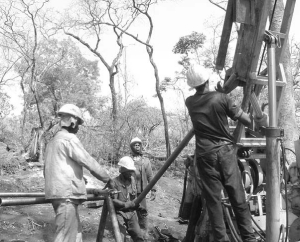Being the lone Western mining company in a developing country presents its share of challenges.
Witness Axmin (AXM-V), a company that holds the gold-rich Passendro project in the Central African Republic (CAR).
Axmin’s problems in the country have been well documented: a confluence of the financial crisis and what the market deemed as unfriendly government behaviour.
The latter had do to with the government stalling on granting a mining licence and its removal of the company’s rights to iron ore discovered on a property adjacent to Passendro.
The situation was so dire that at the beginning of the year Axmin was considering selling all of its shares to an unnamed suitor for just 4.5¢ per share — a remarkably low figure given that its shares had been trading in the 90¢-to $1.00-range leading up to the 2008 recession.
But just as the price of gold climbs to new heights, Axmin’s fortunes have begun to turn around.
The key positive development came in August when the CAR government granted it the long-awaited mining licence.
CAR’s Minister of Mines, Lt.- Col. Sylvain Ndoutingai, who was in Toronto on Oct. 5 to meet with the investment community, told the gathering that the mining permit is the final document the company needs to proceed all the way into production.
What is more, Ndoutingai stressed, is that the government is committed to seeing Axmin turn Passendro into a successful mine.
If investors weren’t convinced of such commitment by Ndoutingai’s long journey to Toronto on behalf of the company, perhaps they will be persuaded by its stake in Axmin itself.
In contrast to many other sub- Saharan African countries, the new mining agreement does not include a 10% free-carried interest in the project.
Instead, Axmin’s chief executive George Roach, shrewdly negotiated for the government to take a combination of shares and warrants in Axmin. If all the warrants are exercised the government would have a 10% stake in Axmin at its current level of common equity.
“My view was that if the state became a shareholder then it would share in the wealth creation of every other shareholder,” Roach says. “They have the same common interest as other shareholders and it’s a real and tangible interest right now, not something that is a 10% pie-in-the-sky figure out in the future. It’s a real thing.”
Roach’s last point refers to the fact that under the previous 10% free-carried interest arrangement, the government would only begin to see revenue flow into its coffers after the mine had been built and producing gold for some five years.
Still, investors attending the meeting had concerns over the country’s mining code — in particular that it requires companies to apply for permits specific to a given metal.
While that process may seem cumbersome to exploration juniors, Ndoutingai explained that it was introduced due to the state’s poor geological knowledge.
Because CAR doesn’t yet have a handle on what resources lie under its soil, Ndoutingai argued, it hopes the mining legislation will encourage companies to explore, report what they have found to the government, apply for permits on the minerals they find most desirable and leave the other minerals open to exploitation by other companies.
Further, Ndoutingai said, in granting the mining permit to Axmin, the government has shown that it will stand by its prior commitments even if the mining law changes. This is in reference to the fact that the country overhauled its mining code last year, but allowed Axmin to be grandfathered in.
Axmin now must hope that such support from the government translates into an upward revaluation from the market. While most of its peers have long since recaptured much of the market cap lost in the doldrums of 2008, Axmin shares have continued to languish, as evidenced by their 11.5¢ close in Toronto on Oct. 5.
That low market cap exists despite the fact that the company holds a project that can turn out 200,000 oz. gold per year over a 5.9-year mine life at average cash costs of US$379 per oz. Those numbers came out of a 2008 feasibility study that used a US$750 oz. gold price. Axmin plans to have an updated study out using more current metrics for the beginning of next year.
The project has reserves of 1.3 million oz. gold grading 2.4 grams gold, measured and indicated resource of 2.03 million oz. gold averaging 2 grams gold and an inferred resource of another 1.1 million oz. of 1.6 grams gold.
As of June 30, Axmin had $7.8 million in cash and equivalents. It will look to raise the funds necessary to develop Passendro through a combination of debt and equity.


Be the first to comment on "Axmin back on track with CAR’s support (October 18, 2010)"